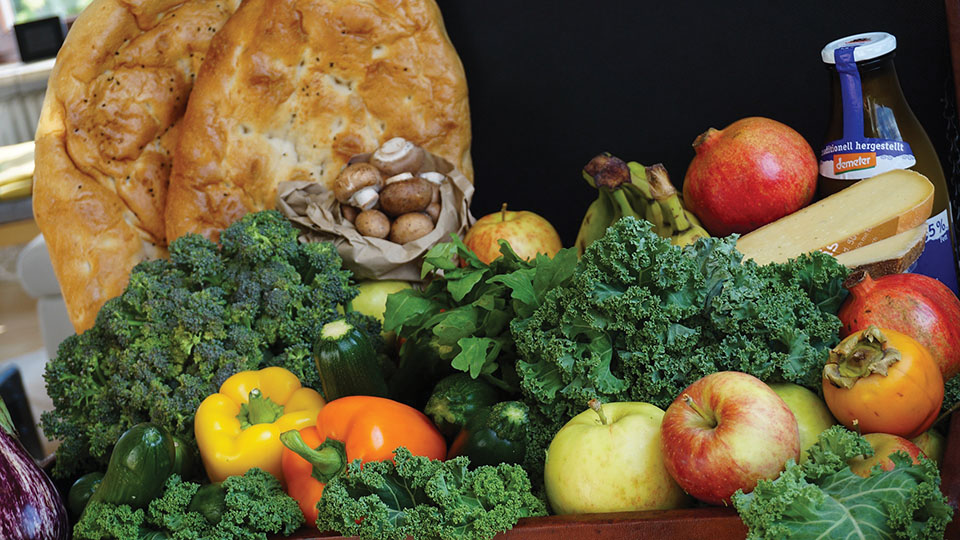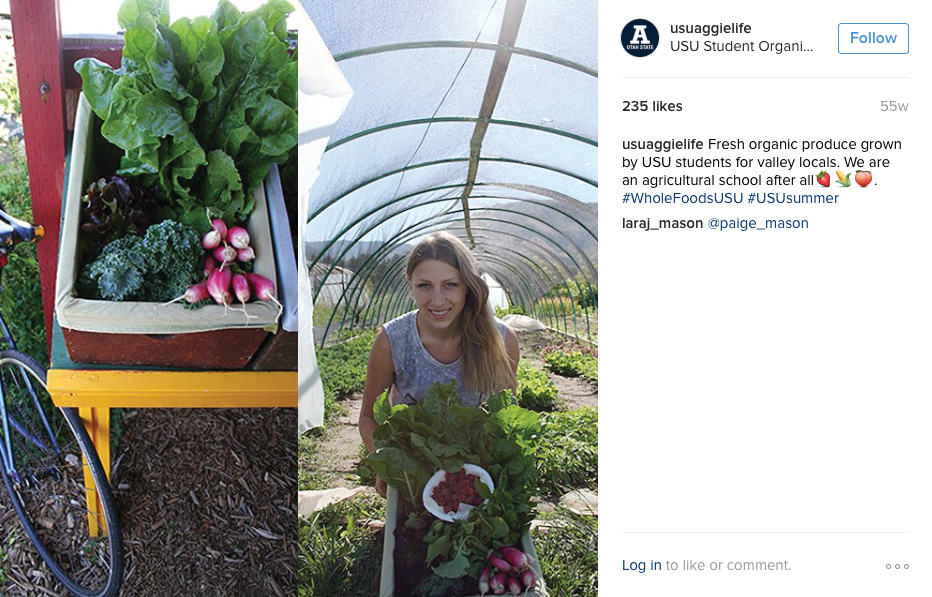Community Supported Agriculture: Marketing & Outreach Strategies to Encourage Membership

When you market your community supported agriculture (CSA) operation, you should consider the best communication
tools to delivering information to potential and current shareholders, engaging your shareholders, and getting feedback. This article will provide tips on how to do so.
Community-Based Social Marketing
Community-based social marketing (CBSM) is a set of marketing strategies aimed at the community level to encourage successful, positive environmental behavior change (Andreasen, 1994). CSAs can effectively use this marketing strategy in promoting the purchase of locally grown produce rather than purchase from the grocery store.The key to achieving this change is by understanding the target audience and by creating motivation. McKenzie-Mohr (2011) explains this can be accomplished by the following steps:
- Selecting behaviors to target and promote (i.e. purchasing local instead of grocery store produce)
- Identifying the perceived barriers and benefits of operating a CSA (from the lens of shareholders)
- Creating a strategy, aimed at changing behavior, from a set of tools including commitment, social norms, prompts, communication, incentives, and convenience
- Piloting the CBSM strategy on a small scale
- Implementing the strategies and evaluating how the behavior has changed
Defining barriers and benefits to operating a CSA is important for choosing what strategies to employ in the CBSM plan. The idea of these strategies is to market the benefits of the behavior you wish to encourage and the barriers of the behavior you wish to discourage (McKenzie-Mohr, 2011). Strategies include:
Commitment
The “foot-in-the-door” technique has been proven to increase commitment by asking small requests first, such as following the CSA on Facebook, then increasing to larger requests, such as attending a social event or workshop (McKenzie-Mohr, 2011). If shareholders agreed to previous requests, they will have internal motivation to agree to your larger proposition like joining your CSA as a shareholder (McKenzie-Mohr, 2011).
Enforcing Social Norms
Social norms are inherent standards in which people base their actions, label themselves, and perceive ideas. Some social norms of shareholders may include positive feelings toward environmental sustainability, involvement within the community, and interest in fresh, local foods. Marketing can be geared toward those who share these social norms in attempt to gain more shareholders. You can create and encourage these social norms by communicating how important it is to participate in this behavior, or how popular their behavior is through word of mouth, posters, fliers, website, or brochure.
Prompts
Prompts are short visual or auditory reminders (Kennedy, 2010). You can use posters, fliers, stickers, and social media posts to prompt people to take actions such as purchasing a share, picking up their produce, or attending an event.
Communication
Communication generates interest, trust, and builds relationships, resulting in consumer involvement and loyalty. Using trending images and sayings, such as “Keep Calm, Join our CSA” can be a fun way to reach out to new audiences.
Incentives
Incentives are benefits that entice people to take action. For example, one Utah CSA offered sales on the next season’s CSA if shareholders signed up by a certain date
Convienience
Convenience limits external barriers, such as consumers’ lack of understanding about CSAs or how to sign up. Barriers can be addressed by increasing communication and advertising between you and community members.
The next major step to CBSM is to enact the strategies through a small-scale pilot test of your CSA and make
alterations in order to find what works best. Once your CSA and marketing communication are successful, then it can be implemented on a larger scale.The final step is to assess how consumer behavior has changed. For example, you can measure the number of subscribers to a blog, electronic newsletter, Facebook page, Twitter, YouTube, or Instagram account. Another example is to calculate the number of registered shareholders in relation to previous seasons.
Using Communication Tools
You can choose from a variety of communication tools when deciding what would work best to advertise your CSAoperation and communicate with your shareholders.
- Word-of-Mouth: Word-of-mouth communication focuses on positive reviews from consumers to others. Positive word-of mouth can be encouraged by asking members to share with their friends, give testimonials, and recruit new members (Bruch & Ernst, 2010). This type of communication has a significant positive impact on CSAs.
- Brochures: Brochures are a great way to gather and communicate information. Brochures summarize who you are, your story, where you’re located, produce offered throughout the season, cost of shares, and contact information. Brochures are also simple to distribute.
- Fliers: Fliers are a way to raise awareness of registration deadlines, pick-up times, social events, and much more. They quickly give basic and necessary information that encourage potential shareholders to become more involved. Fliers can be distributed in public places such as grocery stores, co-ops, libraries, community centers, wellness centers, or workplaces.
- Websites: It is important to have business information online and this does not have to be extravagant or costly. Website builder companies, such as Weebly, WordPress, or Wix, offer free and paid services to create a website. With several templates to choose from, CSA websites can easily be created. It is necessary that websites relay professionalism and the proper information. An example of a Utah CSA’s website is Borski Farms Organic Produce: http://www.borskifarms.org/
- Blogs: Blogs are an excellent platform to share what has been planted, the status of crops, recipes, workshop information, media, and much more. Blogs posts should include images, videos, and links to information in order to appeal to readers. It is important the blog remain current and updated. WordPress.com and Blogger.com are popular blogging services that offer free and easyto-use blog templates. Simply choose a blog layout and begin creating. An example of a Utah CSA blog is The Forbes Family Farm: https://theforbesfamilyfarm.com/blog/
- Emails: Emailing is an effective way of communicating directly with shareholders. Since most people own smartphones, emails can be read and responded to quickly. However, it is important not to spam shareholders with multiple emails too often. Emails are a great platform to distribute timely information including updates of distribution schedules, alterations in pricing, changes in offered produce, upcoming events, or general farm news.
- Electronic Newsletters: Newsletters are a great way to communicate progress to shareholders and keep them
updated. They offer a platform to share recipes, workshop information, delivery schedules, what to do with surplus produce (jamming, freezing, pickling, etc.), upcoming events, or farm safety. Newsletters can instantly be sent out in a mass message to all shareholders. Several online sites, such as MailChimp, offer free services for creating online newsletters for businesses. - CSA Open House: An open house is a great way for potential shareholders to get to know local CSA growers. In the past, both CSA Utah (a program of the Great Salt Lake Resource and Development Council), and the Utah Department of Agriculture and Food have hosted a large open house free to the public, involving several local farms. Community members are invited to meet several CSA growers, learn what they offer, and decide which CSA would be best for them.
- Social Media: Social media provides free advertising and creates trust as shareholders talk about products,
give feedback, and share with their friends. Platforms for social media include Facebook, Twitter, Instagram, and YouTube. Social media management tools allow you to coordinate posts on multiple social sites from one place. Social Sprout is a great place to create and schedule posts for several accounts including Facebook, Instagram, and Twitter. You can join conversations and track the data of your posts. HootSuite is another social media management tool that allows you to publish and track posts on Facebook, Instagram, Twitter, and YouTube. Management tools allow you to analyze data from your online presences and review what consumers are saying.

Seeking Feedback from Shareholders
Receiving feedback from shareholders is a great way for CSAs to know how to improve in order to increase overall success. One way of generating feedback is through administering surveys. Surveys should be administered at the end of the season after shareholders have experienced the entire package. Another way of receiving feedback is by encouraging shareholders to respond to social media posts, emails, and electronic newsletters. You should be sure that your website has a place where shareholders can send comments or suggestions.Summary
Marketing is an important component of CSA operations. CBSM can be used to market a CSA and encourage community members to purchase local food. It is important for you to know your target audience, identify the barriers and benefits to operating a CSA, select communication tools that deliver information to potential shareholders interested in joining a CSA, and use communication tools to share information with shareholders during the CSA season.View Pdf of Article
References
- Andreasen, A. R. (1994). Social Marketing: Its definition and domain. Journal of Public Policy & Marketing, 13(1), 108-114, Retrieved from http://www.jstor.org/stable/30000176?seq=5#page_scan_tab_contents
- Bruch, M. L., & Ernst, M. D. (2010). A farmer’s guide to marketing CSAs (PB1797). Retrieved from University of Tenessee Extension website: https://extension.tennessee.edu/publications/documents/pb1797.pdf
- Kennedy, A. L. (2010). Using community-based social marketing techniques to enhance environmental regulation.
Sustainability, 2(4), 1138-1160. https://doi.org/10.3390/su2041138 - McKenzie-Mohr, D. (2011). Fostering sustainable behavior: An introduction to community-based social marketing.
Gabriola Island, BC, Canada: New Society Publishers.
Authors
Kenna McMurray,Agriculture Communications Student; Kelsey Hall,Associate Professor; Roslynn Brain McCann,Assocociate Professor



